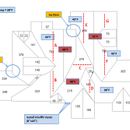Mid Roof Edge Vents / Ice Dams
I’m located in Michigan and in the process of putting on a new roof and want to address some issues relative to poor ventilation and ice dams. Overall, the attic is well insulated, but because of the roof design the hip roof in the center has almost no air intake. My plan was to address this using mid roof edge vents.
There are two spots where ice dams are a problem. When it snows, the first part to melt is always the hip, and at the knee walls up to the ridge. The vaulted ceilings (entire right side of house) and most other areas stay nice and cold. I took temperature measurements in the attic the other day in each zone. Temperature measurements just confirm why the snow is melting first in these areas. In order to cool these areas down, I need more air.
I attached a detailed pdf file with pictures, eagle view, and my proposed location for edge vents. You will see there are both ridge and can vents in the pictures. The new roof will be just ridge vents. I’ve studied this as much as I can, but have no practical experience in this sort of thing so I’m looking for additional opinions. If I did everything proposed, my intake would exceed the exhaust by a fair margin. What do you think? Is this overkill?
The pdf file was too large to upload. Here is a link to download
https://www.dropbox.com/s/qybhkjooy50xb6i/Ventilation%20Specs%20-%20Forum.pdf?dl=0
GBA Detail Library
A collection of one thousand construction details organized by climate and house part










Replies
Thanks for the detailed pictures and diagrams. I have to admit I got a little overwhelmed by the complexity and gave up on understanding it all. But I want to respond to one thing anyway: "In order to cool these areas down, I need more air. " It might be that you have air leaks from the conditioned spaces or from ducts into those areas, and that's where the heat is coming from. So you might need less air (leaks). You might be able to solve the problem by reducing conditioned air leaks, or by adding vents, or maybe you need both. But if you fix the leaks first, you save energy and help the ice dam problem, whereas adding vents only gives you one of those two benefits.
Do you have any recessed light fixtures in the ceilings near those hot areas? Those are notorious for leaking conditioned air into the attic.
That roof boggles my mind!
Your ice dams will be eliminated by sealing attic air leaks and improving the insulation on the attic floor. More ventilation probably won't help much.
It certainly is an interesting roof design! You should see the attic. It's wild. Almost need to be a pro rock climber. I built some permanent ladders to make it easier to climb around.
The air ducts probably aren't perfect, but they are all wrapped in insulation and seams have been taped. I've also sealed most of the holes in the attic where wiring or plumbing comes in so I think I got most of the big air leaks. Blown in insulation was also added on top of the fiberglass. I do think the duct work above the bonus room needs more insulation. It's so close to the roof and if you lean on the duct work you can feel the heat through conduction.
When you go into the attic space that was the same as the outside temp, you can feel the air movement. The other areas that are warmer the air feels more stagnant.
Robert,
This roof is a nightmare. The fundamental problem is a design problem; it may be almost unfixable. This happens a lot, unfortunately. An architect comes up with a design, and the energy experts are called in later to pick up the pieces: "It isn't working; can you please fix it?" There is a special circle in hell reserved for designers who create roofs like this.
For more information on this topic, see Martin’s Ten Rules of Roof Design.
In general, venting changes don't solve ice dam problems on roofs like this. Dynamite does.
Since dynamite isn't an option, the most likely solution would be to cover the roof with SIPs or ventilated nailbase to reduce the heat transfer to the roofing. The solution will cost tens of thousands of dollars.